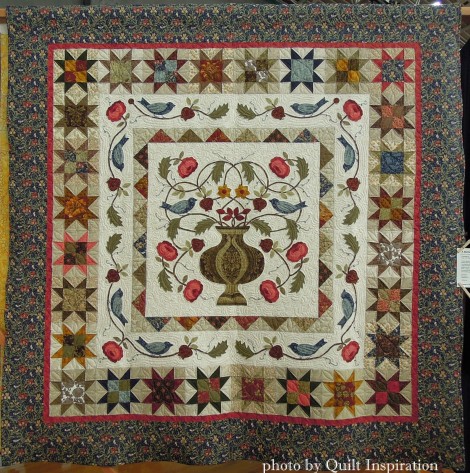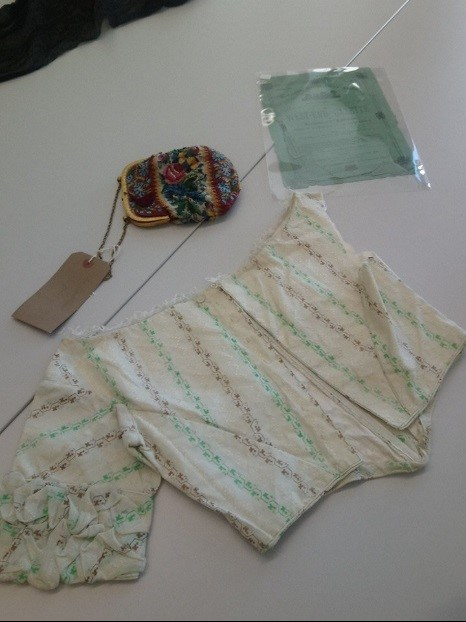Helen McKenzie is a PhD student at Cardiff University whose research is on conceptions of authorship in Mary Elizabeth Braddon’s fiction. Through the fictional writers in the novels, her research considers Braddon’s influential relationship with the Victorian literary marketplace. She tweets @H_McKenzie_

‘A Matter of Morris’ by Mary Mix, quilted by Janice Skiles [accessed from http://quiltinspiration.blogspot.com]
Each paper looked at a pattern and then each panel made its own distinctive pattern through the interactions between its papers and question-and-answer session. Yet, panels had clear dialogues between them bringing together patterns from diverse spheres of Victorian society and Victorian studies. When the panels were stitched together with the Keynotes, the Plenary, the President’s Panel and the Grand Gothic Magic Lantern Show, BAVS 2018 as a whole formed a patchwork quilt.
In the President’s Panel, Ann Heilmann drew our attention to the tension between BAVS’s unified pattern and a multitude of patterns from a multitude of perspectives. I am fascinated by this paradox which haunts all conferences, as well as research more generally. Purely practically, at a conference as huge as BAVS we cannot all go and see every panel, which immediately leads to everyone having a slightly different experience and view point. (Also practically, I am sure that I am not the only one that listens extra carefully if we are chairing a panel and/or am overcome with nerves if speaking in a panel!) These are all things which affect our perspective on a conference.
From my own perspective, I was able to identify distinct patterns across what initially appeared as a ragbag of research tops, themes and approaches. Partly because I love fabric and sewing but also because of the workshop I went to, my gaze was drawn to papers bringing together literature and fashion. At the PGR workshop ‘Working with Material Collections’, I was lucky enough to start BAVS with the opportunity to hold and ‘read’ beautiful items of clothing, purses and magazine articles from the archives at Killerton House – the most important tip is not to go sniffing clothes as who knows what bacteria or bugs might be hiding in there….!!! I also had the opportunity to look through early kaleidoscopes and chromotropes brought from the Bill Douglas Cinema Museum, allowing me the chance to step a little closer to Victorian life.

Items from Killerton House: PGR Workshop – Working with Material Collections Fashion and Film, BAVS 2018

Victorian Chromotropes – Bill Douglas Cinema Museum, University of Exeter: PGR Workshop – Working with Material Collections Fashion and Film, BAVS 2018
The clothes I held in the workshop were perhaps most obviously connected with the panel entitled ‘Fashion and Victorian Pattern-Making’; in these papers we saw images of dresses in Kate Strasdin’s paper, ‘Pattern as Memento: The Case of the 19th Century Dress Diary’ (some of which I wish I could wear!), and then patterns for young boys’ outfits in Clare Rose’s paper, ‘The Value of Pattern: Copyrighting Clothing Designs in the Board of Trade Registers, 1842-1883’. Importantly, these overtly visual papers were placed alongside a more literary paper by Mona Albassam considering ‘“Quaker-like” Plainness in the Works of Charlotte Brontë’.

1850s gauze dress, Kate Strasdin, ‘Pattern as Memento: The Case of the 19th Century Dress Diary’, BAVS 2018
From my angle, the theme of fabric intersected with my own research on Mary Elizabeth Braddon and the Victorian literary marketplace throughout the conference. Isabelle Staniaszek’s paper on Braddon and French medical knowledge linked most directly with my work, but the dialogue between writing and sewing also drew me to Di Yang’s paper ‘“Checks or Spots”: Textile Patterns, Tradition and Female Community in George Eliot’s Novels’, for example. She considered fabric patterns and sewing in both a physical and fictional sense discussing the vivid descriptions of women sewing.
I am well aware that I was not the only one led by a mixture of my research, the workshops and these panels, to experience the pattern of publishing, interior decoration and fashion at BAVS 2018. However, I am also aware of a multitude of patterns of scholarship on the global, Neo-Victorianism, genre, disability, biography, gender, art history and design history experienced by other delegates, to name but a few. Invaluably, each individual perceives a particular perspective on the conference’s wealth of research.
Yet aspects of BAVS are shared by everyone: the Keynotes, the Plenary, the President’s Panel, the dinner, the quiz and the Grand Gothic Magic Lantern Show. For instance, Marion Thain and Grace Lee-Maffei’s Keynotes both addressed the complex interaction between the physical and the conceptual, the actual and the abstract. Although, the Grand Gothic Magic Lantern Show was perhaps the most collective experience as we sat together as an audience in the dark watching stories unfold in the slides.

Grand Gothic Magic Lantern Entertainment, Carolyn and Jeremy Brooker, BAVS 2018
From both the collective and individual patterns seen at BAVS, there are of course threads left at the end in the form of both questions and new ideas. As the President’s Panel and Closing Remarks acknowledged and tackled, there are some (huge!) questions surrounding the future for BAVS in light of Brexit, REF and an already fraught job market. As a (panicking!) PGR approaching the end of my thesis, I greatly appreciated the careers workshop offered and the mentor/mentee scheme, and hope that they are used in future BAVS conferences.
None of these questions can be answered in just one session but BAVS was brought to a close with a sense of determination and hope. I know I wasn’t the only one to sit on the train with a long list of books to read and a notebook full of scribbled thoughts. Threads and patterns from the BAVS patchwork quilt will be stitched into future conferences, publications and theses.